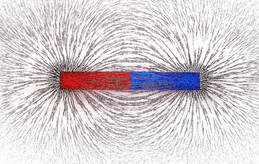Iron filings on the magnetic field on a magnet. Magnetic force field around two bar magnets showing attraction between the north and south poles, visualised with Group of iron filings show magnetic field lines over strong circle magnet. 'Iron filings are very small pieces of iron that look like a light powder. Since iron is a ferromagnetic material, a magnetic field induces each particle to become a tiny bar magnet. The south pole of each particle then attracts the north poles of its neighbors, and this process is repeated over a wide area creates chains of filings parallel to the direction of the magnetic field.' Experiment with magnetic fields using iron filings. Place a magnet under a piece of paper and shake the filings on top. The filings will reveal the magnetic field lines. Hint: Place your magnet in a plastic bag to avoid the mess of cleaning iron filings off your magnet. You can use a plotting compass or iron filings to detect a magnetic field: put a piece of paper over a magnet (this stops the iron filings sticking to the magnet) sprinkle iron filings onto the. Clean iron filings Finally, I put the iron filings into water to clean them. It is easy to separate the iron filings from dirt: Just shake the glass and place a magnet to the bottom side. The dirt stays in the water and can easily be removed. The iron filings stay on the glass bottom.
Iron filings are, as their name suggests, filed pieces of iron that look like a metallic powder. Their properties are, in some aspects, similar to ferrofluid, because they form a significant pattern when interacting with a magnet. Magnetic fields are invisible, but the pattern that both substances form represents the lines of a magnetic field.
Pairing iron filings and magnets together is probably one of the most common, preliminary experiments used to show magnetism. Despite its commonality it is still an interesting way to display the magnetic field. Conduct your own experiment with iron filings and these simple steps!
- White paper
Alternatively, you can eliminate the risk of making a mess by using one of our magnetic demonstrators. If you want to go a step further with your lesson or want a neat desk or classroom display, we also have 3D magnetic demonstrators! The 3D version can be even more representative of the lines of force because they are inherently a 3D phenomenon, running vertical and horizontal as well as sideways.
- Place a piece of white paper on a flat surface.
- Pour some iron filings onto the center of the paper. Be careful when pouring them to avoid ingesting or breathing in powder from them. Also, leave enough space around the edges of the paper to allow you to pick it up without spilling its contents.
- Pick up the paper from the surface carefully. Take the magnet and place it between the paper and flat surface.
- You should see the iron filings spike up as the magnet nears the bottom of the paper. As you move the magnet around, the formation of the filings will change accordingly.
Here are a few questions to ask during and after the experiment:
What if the magnet strength was heightened? Would the pattern differ?
- The answer would be yes. Both the strength and shape of a magnet can affect the way the lines form.
Are magnetic fields visible with the naked eye?
Iron Filings Magnet
- No, however, we can view the directions that they run with this experiment. You can view this neat film on invisible fields from NASA and Semiconductor Films for a deeper look into their mysterious nature.

There are an assortment of experiments that you can do with iron filings and magnets to aid in teaching magnetism. We hope that you enjoyed this one! If you want to try a similar experiment that involves ferrofluid and magnets, you can visit the blog article here. If you have your own version of a magnet experiment that you would like to share, feel free to do so in the comments or on our Facebook page!
What Metals Are Magnetic
Photo by Jlahorn
